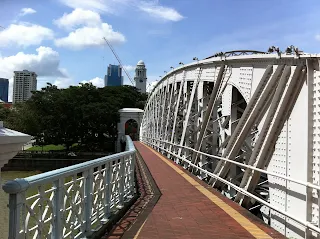
Singapore has been touted as a melting pot of various ethnic migrants, a meeting point across trade routes and a strategic location for anchoring oneself before fanning out across the Asia Pacific region. It can be seen as soaking up good ideas, quality talent and fusion food. Walking around the Singapore River one Friday evening, I was reminded of the two great cultural, political and economic powers that have significantly shaped this island - Britain and China. Above - the lion head , one out of two, guarding the flagship branch of the Bank of China.
The fan palm (above) is symbolic of the equatorial flora of South-east Asia, and it is a favourite of the Singapore Government in the selection of plants and trees used to make the nation green. Although also found in northern Australia, Mexico and California, the plant originated from India and can be spectacular, growing to heights of six metres.
Cavenagh Bridge (below and above) is now a pedestrian bridge, but has a glorious history and tradition. It was designed by John Turnbull Thompson and built by P & W Maclellan of Glasgow, Scotland. The name of the bridge was made in honour of the last India-appointed Governor of the Straits Settlements, Major-General William Orfeur Cavenagh. It also played a pivotal role during the Japanese occupation of Singapore, when the island was renamed Syonan.



The Cavenagh Bridage, above, has more steel suspension struts than most of its peers built in the late 19th century. When completed, it was said to have been built to withstand more than four times its expected load as an open bridge for vehicular traffic. Is only drawback is its low draught. Today it plays a role in bridging the cultural and commercial precincts of downtown Singapore, and can be easily located beside the nearby Fullerton Hotel and the Asian Civilisations Museum.






No comments:
Post a Comment